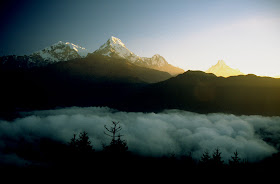Annapurna I
Annapurna I was the first 8,000-metre (26,200 ft) peak to be climbed. Maurice Herzog and Louis Lachenal, of a French expedition led by Maurice Herzog (including Lionel Terray, Gaston Rébuffat, Marcel Ichac, Jean Couzy, Marcel Schatz, Jacques Oudot, Francis de Noyelle), reached the summit on 3 June 1950. (See the documentary of the expedition "Victoire sur l'Annapurna" by Marcel Ichac). Its summit was the highest summit attained on Earth for three years, until the first successful ascent of Mount Everest. (However, higher non-summit points—at least 8,500 metres (27,900 ft)—had already been attained on Everest in the 1920s.)
The south face of Annapurna was first climbed in 1970 by Don Whillans and Dougal Haston, members of a British expedition led by Chris Bonington which included the alpinist Ian Clough, who was killed by a falling serac during the descent. They were, however, beaten to the second ascent of Annapurna by a matter of days by a British Army expedition led by Henry Day.
In 1978, The American Women's Himalayan Expedition, a team led by Arlene Blum, became the first American team to climb Annapurna I. The first summit team, comprising Vera Komarkova and Irene Miller and Sherpas Mingma Tsering and Chewang Ringjing, reached the top at 3:30 p.m. on October 15, 1978. The second summit team, Alison Chadwick-Onyszkiewicz and Vera Watson, died during this climb.
On 3 February 1987, Polish climbers Jerzy Kukuczka and Artur Hajzer made the first winter ascent of Annapurna I.
Annapurna I holds the highest fatality rate among all 14 eight-thousanders. As of 2005, there have been only 103 successful summit attempts, and 56 lives have been lost on the mountain, many to the avalanches for which it is known. Climbers killed on the peak include famed Russian climber Anatoli Boukreev in 1997, Christian Kuntner in 2005 and Iñaki Ochoa in 2008.
On April 27, 2010, Oh Eun-Sun, a South Korean climber, may have become the first woman to ascend the world's 14 highest mountains by climbing the Annapurna with no oxygen. However, her claim to have climbed all 14 is currently treated as disputed by influential record keeper Elizabeth Hawley pending further investigation.
The other peaks
Annapurna II, the eastern anchor of the range, was first climbed in 1960 by a British/Indian/Nepalese team led by Jimmy Roberts, via the West Ridge, approached from the north. The summit party comprised Richard Grant, Chris Bonington, and Sherpa Ang Nyima. In terms of elevation, isolation (distance to a higher summit, namely Annapurna I, 30.5 km/19.0 mi) and prominence (2,437 m/7,995 ft), Annapurna II does not rank far behind Annapurna I. It is a fully independent peak, despite the close association with Annapurna I which its name seems to imply.
Annapurna III was first climbed in 1961 by an Indian expedition led by Capt. Mohan Singh Kohli, via the Northeast Face. The summit party comprised Mohan Kohli, Sonam Gyatso, and Sonam Girmi.
Annapurna IV, near Annapurna II, was first climbed in 1955 by a German expedition led by Heinz Steinmetz, via the North Face and Northwest Ridge. The summit party comprised Steinmetz, Harald Biller, and Jürgen Wellenkamp.
Gangapurna was first climbed in 1965 by a German expedition led by Günther Hauser, via the East Ridge. The summit party comprised 11 members of the expedition.
Annapurna South (also known as Annapurna Dakshin, or Moditse) was first climbed in 1964 by a Japanese expedition, via the North Ridge. The summit party comprised S. Uyeo and Mingma Tsering.
Hiunchuli (6,441 m/21,126 ft) is a satellite peak extending east from Annapurna South, Hiunchuli was first climbed in 1971 by an expedition led by U.S. Peace Corps Volunteer Craig Anderson.
Machapuchare (6,993 m/22,943 ft) is another important peak of the Annapurna Himal, though it just misses the 7,000 metre mark. Machapuchare and Hiunchuli are prominently visible from the valley of Pokhara. These peaks are the "gates" to the Annapurna Sanctuary leading to the immense south face of Annapurna I.



No comments:
Post a Comment